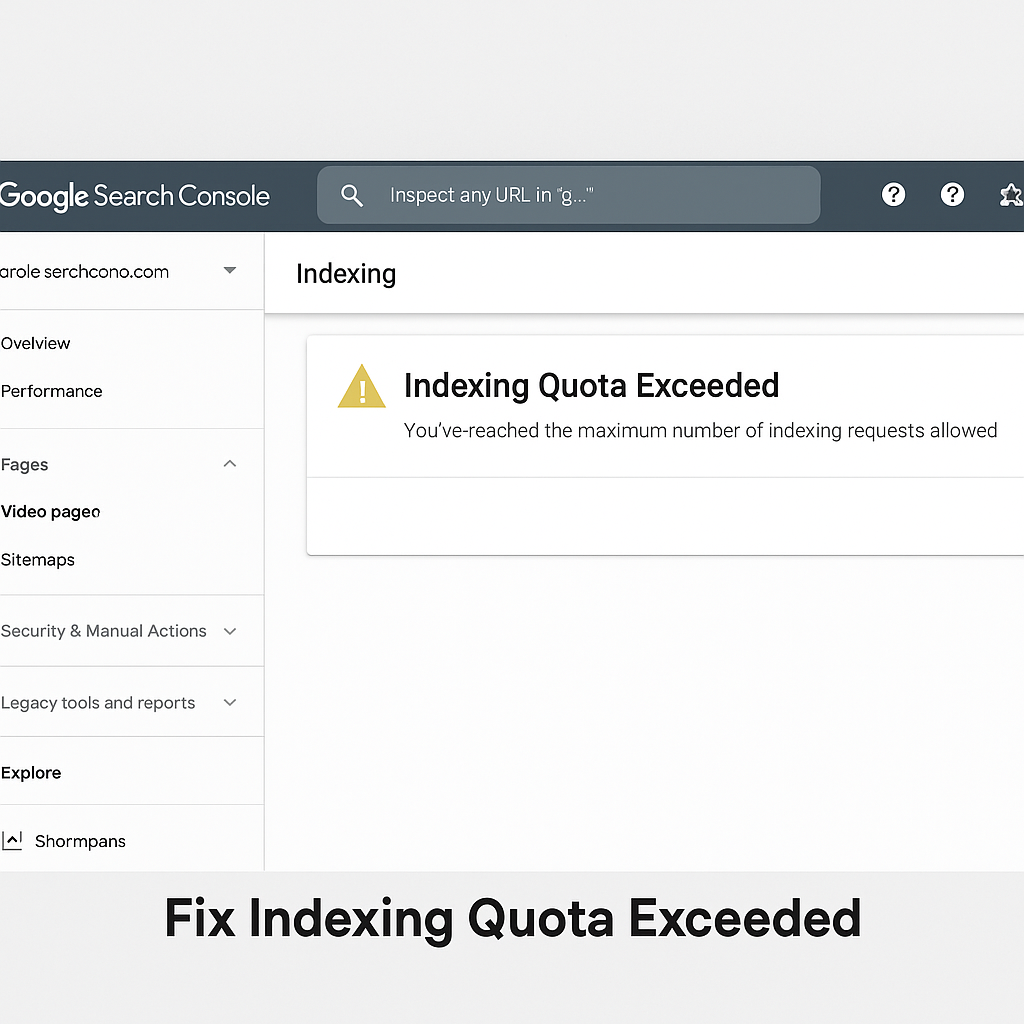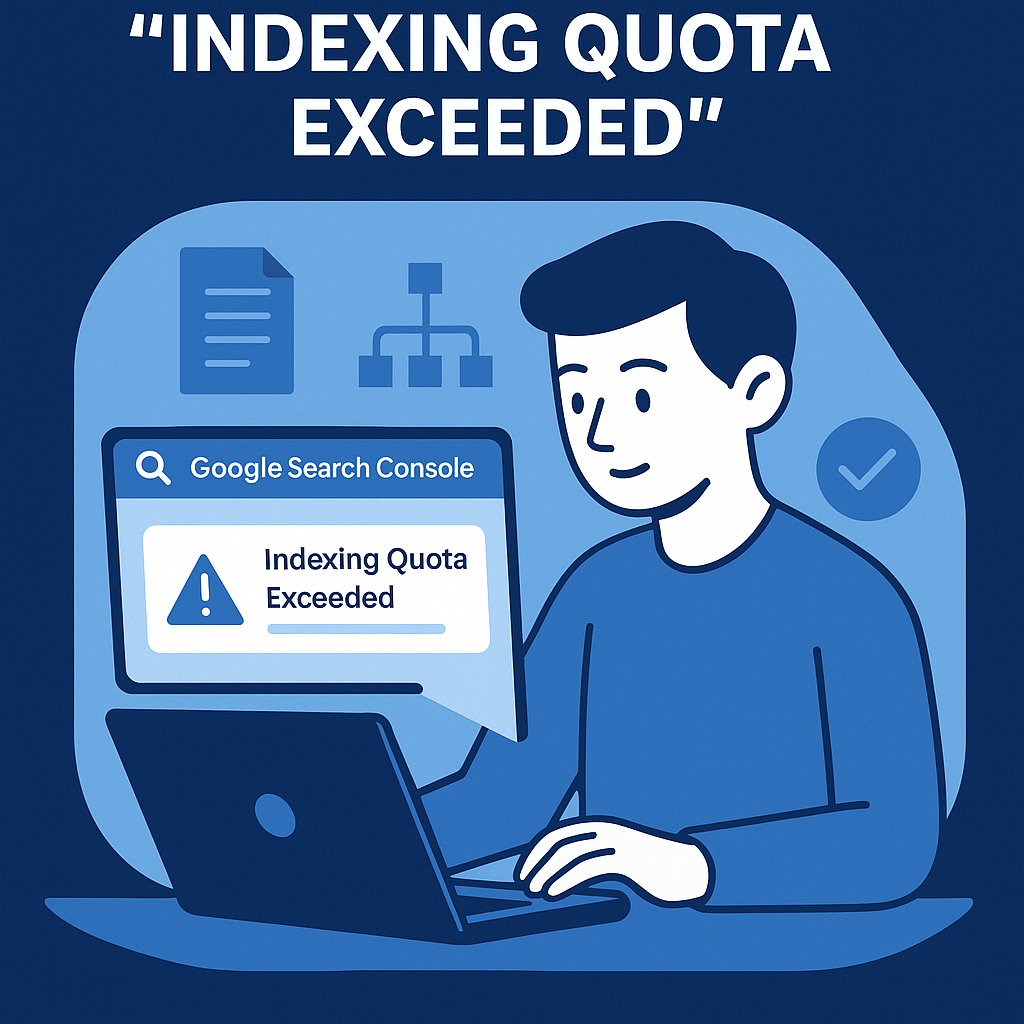“If you’ve seen the Indexing Quota Exceeded message in Google Search Console, this guide explains exactly why it appears and how to fix it safely.”
Introduction
As a blogger, I frequently rely on Google Search Console (GSC). Recently, while managing another blog, I encountered an unexpected obstacle: “Indexing Quota Exceeded” errors when requesting URLs to be indexed. This issue came up right after removing AMP pages and trying to re-request indexing.
In this post, I’ll explain how Google may interpret your indexing requests, why the quota is enforced, and practical ways to overcome and prevent this issue.
If you’re managing a WordPress or SEO-focused blog,
check out Google Search Console Indexing Tips
for additional ways to optimize crawling and avoid quota issues.

1. Removing AMP Pages & Requesting Indexing
Over the past few weeks, I deleted several AMP URLs on my site. After deleting them, I immediately used the URL Inspection → Request Indexing tool to prompt Google to drop the old ones and index the new/updated ones.
At first, the process worked fine—but after submitting multiple requests in succession, I began seeing “quota exceeded” messages. It seems Google viewed this as excessive or potentially spammy behavior.
2. Why Google Enforces Indexing Request Quotas
There are several reasons Google imposes limits:
- Prevent abuse & system load: The URL Inspection → Request Indexing tool is intended for occasional troubleshooting or urgent updates, not bulk indexing.
- Daily / hourly limits: Many SEO users report being allowed to submit only ~10–20 URLs per 24 hours before hitting the quota limit. ultimatewb.com+2Nick LeRoy Consulting+2
- Quota reset timing: After you exceed the limit, you typically must wait ~24 hours (or sometimes hours, depending on your usage) before Google resets your quota.
- No guarantee for quota increase: Google’s John Mueller has said that the quota for “Request Indexing” is unlikely to be dramatically raised, because of misuse and spam.
In short: Google expects you to rely primarily on your site architecture (sitemaps, internal links) to drive indexing, and only use manual requests sparingly.
3. Step-by-Step Solutions & Best Practices
Here are effective steps to recover from a “quota exceeded” state and prevent further issues:
You may also like Google SEO Sitemap Optimization —
a practical guide to building sitemaps that improve crawl efficiency.
A. Pause / Wait
Once you hit the message, stop submitting new requests. Wait until Google resets your quota (usually within 24 hours). Pushing more requests may worsen things.
B. Prioritize critical pages
Only submit your most important pages (e.g. top content, pages you really want indexed) rather than a large batch.
C. Use a well-formed sitemap
- Keep your sitemap updated with all current pages (new, changed, removed).
- Submit (or resubmit) your sitemap in GSC to encourage Google to crawl more broadly and organically.
- In the sitemap, flag
<lastmod>appropriately so Google knows what changed.
D. Handle redirects properly
When deleting AMP or obsolete URLs, use proper 301 redirects to point to relevant canonical pages. This helps Google understand your site structure and avoid “404s” or orphaned content.
E. Monitor Search Console messages & reports
Regularly check for warnings, crawl errors, coverage exclusions, or messages in GSC. If Google sends you messages (e.g. “indexed, but not shown,” “duplicate,” “excluded”), address them promptly.
F. Avoid re-submitting the same URL repeatedly
Submitting the same URL over and over (especially after a failure) won’t accelerate indexing and may contribute to triggering the quota.
G. Improve site “crawlability”
- Use strong internal linking so new/changed pages link from existing high-traffic pages.
- Ensure your pages are not blocked via robots.txt, noindex tags, or canonical issues.
- Clean up site speed, mobile usability, and general SEO health so Google is more eager to crawl.
4. Recovery Strategy: Stepwise Requesting
Here’s a sample plan you might follow when recovering from a quota block:
| Time Window | Action |
|---|---|
| Immediately after quota hit | Pause further request submissions |
| After ~12 hrs | Try requesting 1–2 priority pages only, see if accepted |
| After 24 hrs | Resume normal (but restrained) request volumes |
| Ongoing | Use sitemap + internal linking, minimize manual requests |
Over time, Google will naturally recrawl and index pages if your site is well structured.
5. Things You Should Know (Caveats & Realities)
- Quota is somewhat opaque: Google doesn’t publicly specify exact limits per site/account. Many users estimate ~10–12 requests / day. Nick LeRoy Consulting+1
- Quota increases unlikely: Google is cautious about lifting this limit, due to abuse concerns. Search Engine Roundtable+1
- Sitemaps & natural crawling are primary: Manual indexing requests are secondary tools.
- “Quota Exceeded” may sometimes be a temporary bug or system glitch—so always allow some buffer. BlackHatWorld+1
For more technical fixes and SEO case studies,
visit Blogging SEO Best Practices.

Conclusion & Final Thoughts
If you ever see “Indexing Quota Exceeded” in Google Search Console, don’t panic. It’s a built-in safeguard against abuse. The solution is not aggressive pushing, but patience, prioritization, and letting Google do the heavy lifting via sitemaps and crawl signals.
My experience with removing AMP pages and then hitting the quota taught me: pace yourself, use redirects carefully, and rely more on proper SEO structure than overusing the “Request Indexing” button. Over time, as your site grows in authority and quality, Google will crawl and index more reliably.
Q1. What does “Indexing Quota Exceeded” mean in Google Search Console?
It means you’ve reached the limit of manual URL submissions via “Request Indexing.” Google restricts these to prevent abuse.
Q2. How long do I have to wait before resubmitting URLs?
Usually 24 hours. After that, Google resets the quota and you can submit a few more.
Q3. How can I avoid hitting the quota again?
Rely on sitemaps and internal linking for automatic crawling. Use manual requests only for urgent pages.
Q4. Is there a way to increase the indexing quota?
No. Google’s quota is fixed to prevent spam. Instead, improve your crawlability and site authority.
